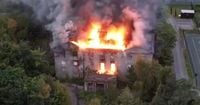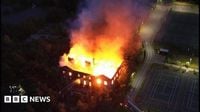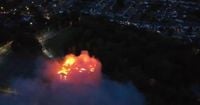On the evening of August 19, 2025, a devastating fire tore through Woolton Hall, one of Liverpool’s oldest and most cherished historic buildings. The blaze, which began just after 8 p.m. BST, quickly engulfed the Grade I-listed manor house on Speke Road, sending plumes of smoke visible as far away as Prescot and drawing the attention—and heartbreak—of the entire community.
Firefighters from Merseyside Fire and Rescue Service (MFRS) responded rapidly. According to the Liverpool Echo, the first call came at 8:09 p.m., and crews arrived on the scene at 8:16 p.m. By then, the situation was already dire. The historic three-storey building, dating back to 1704, was described by fire services as “fully alight,” with flames flickering through its windows and the orange glow visible for miles around. Drone footage shared by the BBC showed the roof entirely consumed by flames, partially collapsed, and thick grey smoke billowing into the night sky.
Woolton Hall is no ordinary structure. Over the centuries, it has served as a manor home, a private school, an army hospital, a convent, and a hotel. Its architectural and cultural significance led to its rescue from demolition in the 1980s and the awarding of Grade I-listed status. But in recent years, the building had fallen into disrepair, and in 2021, it was added to Historic England’s Heritage at Risk register as a Category A site, following a previous fire in 2019 that was treated as arson by police. Back then, fire crews managed to save the building, but the risk of further damage loomed large—a risk that, tragically, materialized this week.
As the fire raged on, the response was both swift and immense. According to Sky News, five fire engines and an aerial platform were initially deployed, with that number rising to nine engines and an aerial appliance as the scale of the disaster became clear. Firefighters worked tirelessly, deploying main jet hoses and using aerial appliances to attack the blaze from outside, as the interior was deemed too dangerous to enter. A building surveyor, after assessing the structure, advised that it was unsafe to commit crews inside—underscoring the peril faced by those on the front lines.
Efforts to contain the fire extended beyond the manor itself. With the roof collapsed and the flames threatening to spread, crews dampened the surrounding woodlands and used the aerial platform to protect adjacent buildings, including a nearby school. The incident was so severe that the road was closed in both directions, with Merseyside Police assisting in traffic management. Residents living nearby were advised to keep doors and windows closed to shield themselves from the smoke, and drivers were urged to avoid the area entirely. As Daily Mail reported, the smell of smoke lingered in the surrounding roads, and the sight of the burning building left many locals shaken.
Ben Haslam, a reporter on the scene for the Liverpool Echo, described the atmosphere: “There’s a smell of smoke in the roads that surround the hall, the orange can be seen in the sky for quite a distance.” He noted that people were being ejected from the woods as police worked to maintain safety, with one witness recounting how a tree caught fire before authorities intervened.
For the community, the loss is deeply personal. Woolton Hall is woven into the fabric of Liverpool’s history, its walls bearing witness to centuries of change and adaptation. Local residents, many of whom watched the flames from their homes or through images circulating online, lamented the blaze as a “travesty” and a “tragic end” for a beloved landmark. The building’s listing as Grade I means it shares the same level of protection and significance as Liverpool Cathedral—a comparison not lost on campaigners.
Jonathon Wild, a prominent advocate for Woolton Hall’s preservation, voiced the anguish felt by many. “This is the same as Liverpool Cathedral going on fire. The same category listing,” he said, as quoted by the Liverpool Echo and Daily Mail. “I am absolutely devastated that this has happened and I ask that the powers that be hold a full investigation into this fire and the outcome is that this building is somehow rebuilt.” Wild’s call for a thorough inquiry and eventual restoration echoed across social media and local news, reflecting both grief and a determination to see the hall’s legacy endure.
The fire’s scale and ferocity presented significant challenges for emergency crews. The blaze was estimated by MFRS to cover an area about 130 feet (40 meters) by 100 feet (30 meters), and the main building, measuring 100 by 100 meters, was described as “well alight.” The incident was divided into sectors for better management, with an MFRS drone deployed to provide situational awareness from above. Despite the collapse of the roof and the ongoing threat of the flames, some progress was made as the night wore on. The fire appeared to reduce in intensity, though the incident remained active for a considerable time, with fire engines and police maintaining a presence well into the early hours of August 20.
This is not the first time Woolton Hall has faced destruction. The 2019 fire, which witnesses described as accompanied by a loud “explosion” and a towering black plume of smoke, was a stark warning of the vulnerability of historic sites left in neglect. Back then, fire crews managed to prevent total loss, but the building’s fate remained precarious—its inclusion on the Heritage at Risk register a testament to the challenges of preserving such landmarks.
As the embers cool and the community surveys the damage, questions abound. How did the fire start? Could more have been done to protect the hall in the years since its last near-miss? And, perhaps most pressing for those who have fought for its survival: what comes next? Calls for a full investigation are mounting, with hopes that lessons will be learned and that, against the odds, Woolton Hall might one day rise from the ashes.
For now, the sight of the gutted shell standing against the Liverpool skyline serves as a somber reminder of the fragility of heritage—and the enduring spirit of those determined to protect it.






